Jianhua Han
ILLUME+: Illuminating Unified MLLM with Dual Visual Tokenization and Diffusion Refinement
Apr 03, 2025Abstract:We present ILLUME+ that leverages dual visual tokenization and a diffusion decoder to improve both deep semantic understanding and high-fidelity image generation. Existing unified models have struggled to simultaneously handle the three fundamental capabilities in a unified model: understanding, generation, and editing. Models like Chameleon and EMU3 utilize VQGAN for image discretization, due to the lack of deep semantic interaction, they lag behind specialist models like LLaVA in visual understanding tasks. To mitigate this, LaViT and ILLUME employ semantic encoders for tokenization, but they struggle with image editing due to poor texture preservation. Meanwhile, Janus series decouples the input and output image representation, limiting their abilities to seamlessly handle interleaved image-text understanding and generation. In contrast, ILLUME+ introduces a unified dual visual tokenizer, DualViTok, which preserves both fine-grained textures and text-aligned semantics while enabling a coarse-to-fine image representation strategy for multimodal understanding and generation. Additionally, we employ a diffusion model as the image detokenizer for enhanced generation quality and efficient super-resolution. ILLUME+ follows a continuous-input, discrete-output scheme within the unified MLLM and adopts a progressive training procedure that supports dynamic resolution across the vision tokenizer, MLLM, and diffusion decoder. This design allows for flexible and efficient context-aware image editing and generation across diverse tasks. ILLUME+ (3B) exhibits competitive performance against existing unified MLLMs and specialized models across multimodal understanding, generation, and editing benchmarks. With its strong performance, ILLUME+ provides a scalable and versatile foundation for future multimodal applications. Project Page: https://illume-unified-mllm.github.io/.
SemHiTok: A Unified Image Tokenizer via Semantic-Guided Hierarchical Codebook for Multimodal Understanding and Generation
Mar 09, 2025Abstract:We present SemHiTok, a unified image Tokenizer via Semantic-Guided Hierarchical codebook that provides consistent discrete feature representations for multimodal understanding and generation tasks. Recently, unified multimodal large models (MLLMs) for understanding and generation have sparked exploration within research community. Previous works attempt to train a unified image tokenizer by combining loss functions for semantic feature reconstruction and pixel reconstruction. However, due to the differing levels of features prioritized by multimodal understanding and generation tasks, joint training methods face significant challenges in achieving a good trade-off. SemHiTok addresses this challenge through Semantic-Guided Hierarchical codebook which builds texture sub-codebooks on pre-trained semantic codebook. This design decouples the training of semantic reconstruction and pixel reconstruction and equips the tokenizer with low-level texture feature extraction capability without degradation of high-level semantic feature extraction ability. Our experiments demonstrate that SemHiTok achieves state-of-the-art rFID score at 256X256resolution compared to other unified tokenizers, and exhibits competitive performance on multimodal understanding and generation tasks.
Can Atomic Step Decomposition Enhance the Self-structured Reasoning of Multimodal Large Models?
Mar 08, 2025Abstract:In this paper, we address the challenging task of multimodal mathematical reasoning by incorporating the ability of "slow thinking" into multimodal large language models (MLLMs). Our core idea is that different levels of reasoning abilities can be combined dynamically to tackle questions with different complexity. To this end, we propose a paradigm of Self-structured Chain of Thought (SCoT), which is composed of minimal semantic atomic steps. Different from existing methods that rely on structured templates or free-form paradigms, our method can not only generate cognitive CoT structures for various complex tasks but also mitigates the phenomenon of overthinking. To introduce structured reasoning capabilities into visual understanding models, we further design a novel AtomThink framework with four key modules, including (i) a data engine to generate high-quality multimodal reasoning paths; (ii) a supervised fine-tuning process with serialized inference data; (iii) a policy-guided multi-turn inference method; and (iv) an atomic capability metric to evaluate the single step utilization rate. We conduct extensive experiments to show that the proposed AtomThink significantly improves the performance of baseline MLLMs, achieving more than 10\% average accuracy gains on MathVista and MathVerse. Compared to state-of-the-art structured CoT approaches, our method not only achieves higher accuracy but also improves data utilization by 5 times and boosts inference efficiency by 85.3\%. Our code is now public available in https://github.com/Quinn777/AtomThink.
TransMamba: Fast Universal Architecture Adaption from Transformers to Mamba
Feb 21, 2025Abstract:Transformers have been favored in both uni-modal and multi-modal foundation models for their flexible scalability in attention modules. Consequently, a number of pre-trained Transformer models, e.g., LLaVA, CLIP, and DEIT, are publicly available. Recent research has introduced subquadratic architectures like Mamba, which enables global awareness with linear complexity. Nevertheless, training specialized subquadratic architectures from scratch for certain tasks is both resource-intensive and time-consuming. As a motivator, we explore cross-architecture training to transfer the ready knowledge in existing Transformer models to alternative architecture Mamba, termed TransMamba. Our approach employs a two-stage strategy to expedite training new Mamba models, ensuring effectiveness in across uni-modal and cross-modal tasks. Concerning architecture disparities, we project the intermediate features into an aligned latent space before transferring knowledge. On top of that, a Weight Subcloning and Adaptive Bidirectional distillation method (WSAB) is introduced for knowledge transfer without limitations on varying layer counts. For cross-modal learning, we propose a cross-Mamba module that integrates language awareness into Mamba's visual features, enhancing the cross-modal interaction capabilities of Mamba architecture. Despite using less than 75% of the training data typically required for training from scratch, TransMamba boasts substantially stronger performance across various network architectures and downstream tasks, including image classification, visual question answering, and text-video retrieval. The code will be publicly available.
ILLUME: Illuminating Your LLMs to See, Draw, and Self-Enhance
Dec 09, 2024Abstract:In this paper, we introduce ILLUME, a unified multimodal large language model (MLLM) that seamlessly integrates multimodal understanding and generation capabilities within a single large language model through a unified next-token prediction formulation. To address the large dataset size typically required for image-text alignment, we propose to enhance data efficiency through the design of a vision tokenizer that incorporates semantic information and a progressive multi-stage training procedure. This approach reduces the dataset size to just 15M for pretraining -- over four times fewer than what is typically needed -- while achieving competitive or even superior performance with existing unified MLLMs, such as Janus. Additionally, to promote synergistic enhancement between understanding and generation capabilities, which is under-explored in previous works, we introduce a novel self-enhancing multimodal alignment scheme. This scheme supervises the MLLM to self-assess the consistency between text descriptions and self-generated images, facilitating the model to interpret images more accurately and avoid unrealistic and incorrect predictions caused by misalignment in image generation. Based on extensive experiments, our proposed ILLUME stands out and competes with state-of-the-art unified MLLMs and specialized models across various benchmarks for multimodal understanding, generation, and editing.
AtomThink: A Slow Thinking Framework for Multimodal Mathematical Reasoning
Nov 18, 2024Abstract:In this paper, we address the challenging task of multimodal mathematical reasoning by incorporating the ability of ``slow thinking" into multimodal large language models (MLLMs). Contrary to existing methods that rely on direct or fast thinking, our key idea is to construct long chains of thought (CoT) consisting of atomic actions in a step-by-step manner, guiding MLLMs to perform complex reasoning. To this end, we design a novel AtomThink framework composed of three key modules: (i) a CoT annotation engine that automatically generates high-quality CoT annotations to address the lack of high-quality visual mathematical data; (ii) an atomic step fine-tuning strategy that jointly optimizes an MLLM and a policy reward model (PRM) for step-wise reasoning; and (iii) four different search strategies that can be applied with the PRM to complete reasoning. Additionally, we propose AtomMATH, a large-scale multimodal dataset of long CoTs, and an atomic capability evaluation metric for mathematical tasks. Extensive experimental results show that the proposed AtomThink significantly improves the performance of baseline MLLMs, achieving approximately 50\% relative accuracy gains on MathVista and 120\% on MathVerse. To support the advancement of multimodal slow-thinking models, we will make our code and dataset publicly available on https://github.com/Quinn777/AtomThink.
VidMan: Exploiting Implicit Dynamics from Video Diffusion Model for Effective Robot Manipulation
Nov 14, 2024Abstract:Recent advancements utilizing large-scale video data for learning video generation models demonstrate significant potential in understanding complex physical dynamics. It suggests the feasibility of leveraging diverse robot trajectory data to develop a unified, dynamics-aware model to enhance robot manipulation. However, given the relatively small amount of available robot data, directly fitting data without considering the relationship between visual observations and actions could lead to suboptimal data utilization. To this end, we propose VidMan (Video Diffusion for Robot Manipulation), a novel framework that employs a two-stage training mechanism inspired by dual-process theory from neuroscience to enhance stability and improve data utilization efficiency. Specifically, in the first stage, VidMan is pre-trained on the Open X-Embodiment dataset (OXE) for predicting future visual trajectories in a video denoising diffusion manner, enabling the model to develop a long horizontal awareness of the environment's dynamics. In the second stage, a flexible yet effective layer-wise self-attention adapter is introduced to transform VidMan into an efficient inverse dynamics model that predicts action modulated by the implicit dynamics knowledge via parameter sharing. Our VidMan framework outperforms state-of-the-art baseline model GR-1 on the CALVIN benchmark, achieving a 11.7% relative improvement, and demonstrates over 9% precision gains on the OXE small-scale dataset. These results provide compelling evidence that world models can significantly enhance the precision of robot action prediction. Codes and models will be public.
EMOVA: Empowering Language Models to See, Hear and Speak with Vivid Emotions
Sep 26, 2024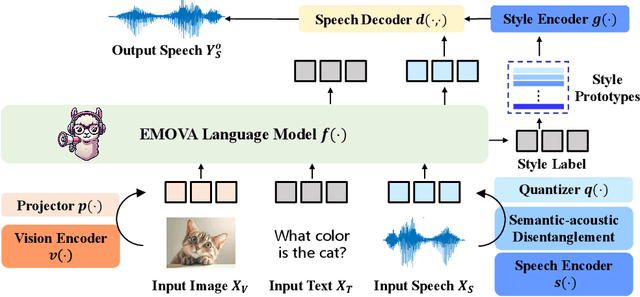
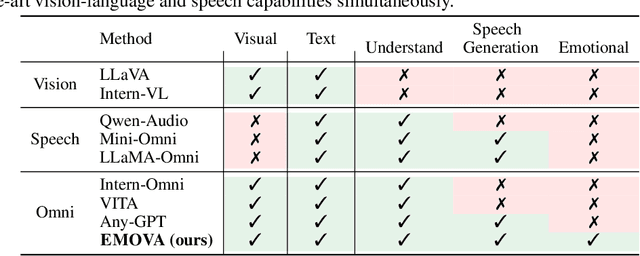
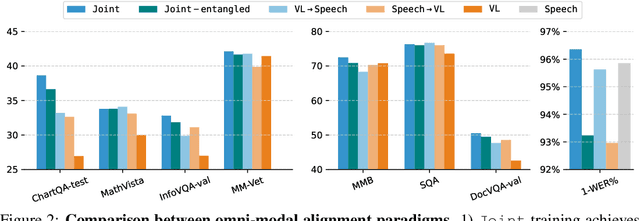
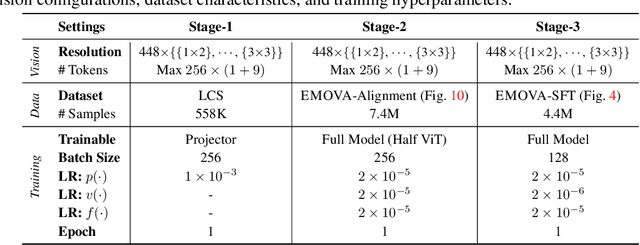
Abstract:GPT-4o, an omni-modal model that enables vocal conversations with diverse emotions and tones, marks a milestone for omni-modal foundation models. However, empowering Large Language Models to perceive and generate images, texts, and speeches end-to-end with publicly available data remains challenging in the open-source community. Existing vision-language models rely on external tools for the speech processing, while speech-language models still suffer from limited or even without vision-understanding abilities. To address this gap, we propose EMOVA (EMotionally Omni-present Voice Assistant), to enable Large Language Models with end-to-end speech capabilities while maintaining the leading vision-language performance. With a semantic-acoustic disentangled speech tokenizer, we notice surprisingly that omni-modal alignment can further enhance vision-language and speech abilities compared with the corresponding bi-modal aligned counterparts. Moreover, a lightweight style module is proposed for flexible speech style controls (e.g., emotions and pitches). For the first time, EMOVA achieves state-of-the-art performance on both the vision-language and speech benchmarks, and meanwhile, supporting omni-modal spoken dialogue with vivid emotions.
UNIT: Unifying Image and Text Recognition in One Vision Encoder
Sep 06, 2024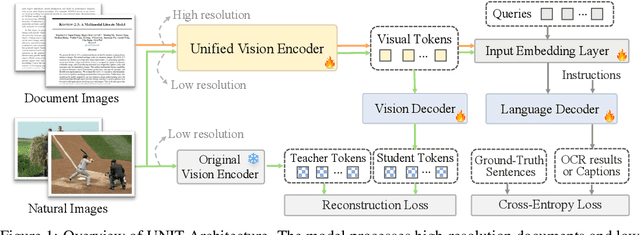



Abstract:Currently, vision encoder models like Vision Transformers (ViTs) typically excel at image recognition tasks but cannot simultaneously support text recognition like human visual recognition. To address this limitation, we propose UNIT, a novel training framework aimed at UNifying Image and Text recognition within a single model. Starting with a vision encoder pre-trained with image recognition tasks, UNIT introduces a lightweight language decoder for predicting text outputs and a lightweight vision decoder to prevent catastrophic forgetting of the original image encoding capabilities. The training process comprises two stages: intra-scale pretraining and inter-scale finetuning. During intra-scale pretraining, UNIT learns unified representations from multi-scale inputs, where images and documents are at their commonly used resolution, to enable fundamental recognition capability. In the inter-scale finetuning stage, the model introduces scale-exchanged data, featuring images and documents at resolutions different from the most commonly used ones, to enhance its scale robustness. Notably, UNIT retains the original vision encoder architecture, making it cost-free in terms of inference and deployment. Experiments across multiple benchmarks confirm that our method significantly outperforms existing methods on document-related tasks (e.g., OCR and DocQA) while maintaining the performances on natural images, demonstrating its ability to substantially enhance text recognition without compromising its core image recognition capabilities.
EasyControl: Transfer ControlNet to Video Diffusion for Controllable Generation and Interpolation
Aug 23, 2024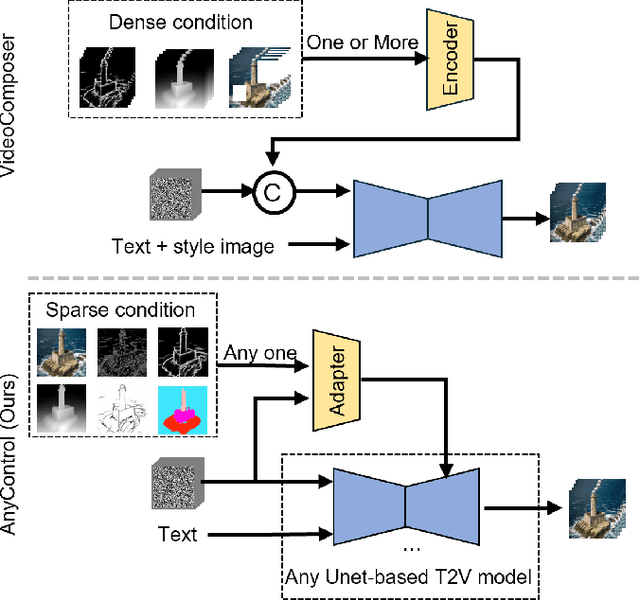
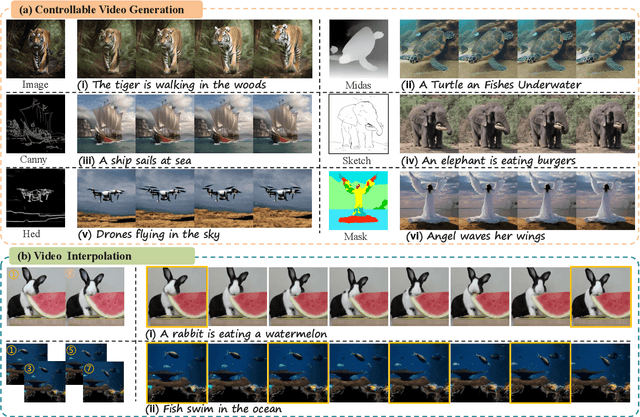
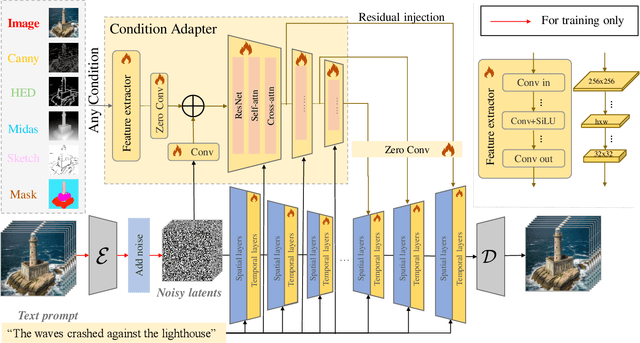
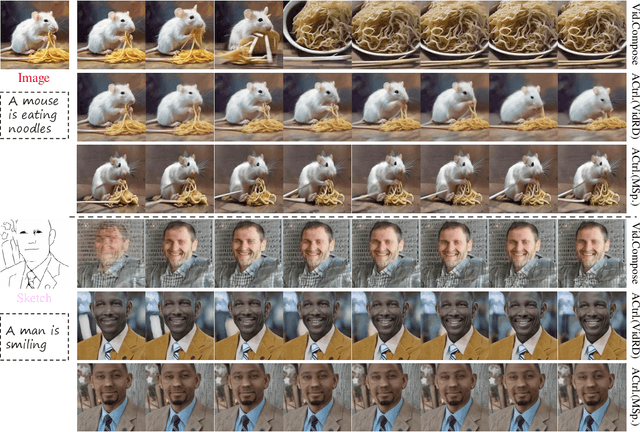
Abstract:Following the advancements in text-guided image generation technology exemplified by Stable Diffusion, video generation is gaining increased attention in the academic community. However, relying solely on text guidance for video generation has serious limitations, as videos contain much richer content than images, especially in terms of motion. This information can hardly be adequately described with plain text. Fortunately, in computer vision, various visual representations can serve as additional control signals to guide generation. With the help of these signals, video generation can be controlled in finer detail, allowing for greater flexibility for different applications. Integrating various controls, however, is nontrivial. In this paper, we propose a universal framework called EasyControl. By propagating and injecting condition features through condition adapters, our method enables users to control video generation with a single condition map. With our framework, various conditions including raw pixels, depth, HED, etc., can be integrated into different Unet-based pre-trained video diffusion models at a low practical cost. We conduct comprehensive experiments on public datasets, and both quantitative and qualitative results indicate that our method outperforms state-of-the-art methods. EasyControl significantly improves various evaluation metrics across multiple validation datasets compared to previous works. Specifically, for the sketch-to-video generation task, EasyControl achieves an improvement of 152.0 on FVD and 19.9 on IS, respectively, in UCF101 compared with VideoComposer. For fidelity, our model demonstrates powerful image retention ability, resulting in high FVD and IS in UCF101 and MSR-VTT compared to other image-to-video models.
 Add to Chrome
Add to Chrome Add to Firefox
Add to Firefox Add to Edge
Add to Edge